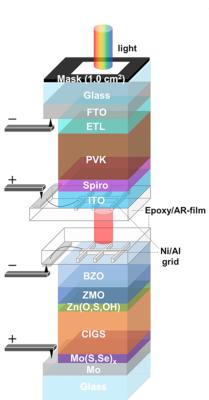Scientists from the University of Tokyo have reported a 26.2% power conversion efficiency for a four-terminal tandem solar cell based on perovskite and copper, indium, gallium and selenium (CIGS). The researchers said these results are a world record for such tandem solar devices and attributed the improvements to the performance of the perovskite top cell.
They built the 1-square-centimeter perovskite device using a transparent conductive material made of indium tin oxide (ITO), which was deposited via sputtering and without thermally evaporated Molybdenum oxides ( MoOx). “By eliminating the use of the MoOx buffer layer, we were able to develop semi-transparent PVK cells with higher durability and transmittance,” the scientists said.
The cell achieved a maximum efficiency of 19.5% and a certified efficiency of 19.3%.
“The effect of ion bombardment during ITO sputtering on widely used spiro-OMeTAD was not detrimental to the device performance, whereas it improved the power conversion efficiency (PCE) owing to the better band alignment caused by oxidation of the HTL,” the researchers explained.
The four-terminal tandem cell, which could be used for rooftop and BIPV applications, was built with a bottom cell CIGS cell that the scientists had previously developed, with an initial overall efficiency of 26.2%.
“By developing this work and continuing research on further improvement of conversion efficiency, it is possible to realize lightweight flexible solar cells exceeding 30%,” they said.
In June 2022, researchers from Wuhan University in China developed a four-junction tandem solar cell based on perovskite and CIGS with a conversion efficiency of 25.5%.


